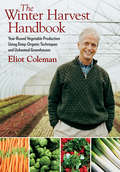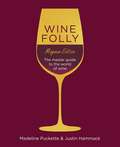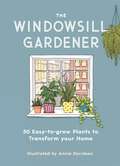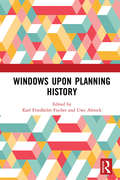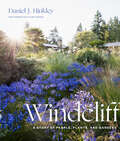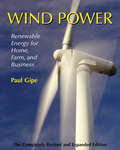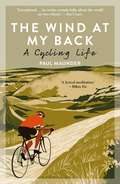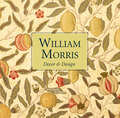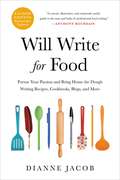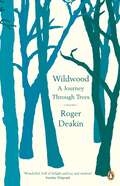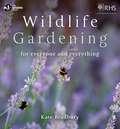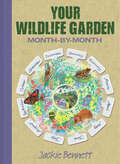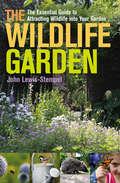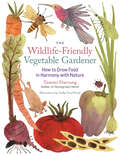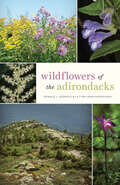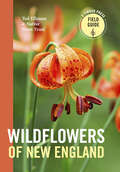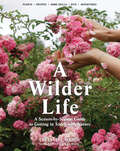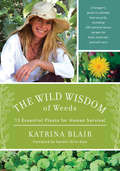- Table View
- List View
The Winter Harvest Handbook: Year Round Vegetable Production Using Deep-Organic Techniques and Unheated Greenhouses
by Eliot Coleman Barbara DamroschChoosing locally grown organic food is a sustainable living trend that’s taken hold throughout North America. Celebrated farming expert Eliot Coleman helped start this movement with The New Organic Grower published 20 years ago. He continues to lead the way, pushing the limits of the harvest season while working his world-renowned organic farm in Harborside, Maine. Now, with his long-awaited new book, The Winter Harvest Handbook, anyone can have access to his hard-won experience. Gardeners and farmers can use the innovative, highly successful methods Coleman describes in this comprehensive handbook to raise crops throughout the coldest of winters. Building on the techniques that hundreds of thousands of farmers and gardeners adopted from The New Organic Grower and Four-Season Harvest, this new book focuses on growing produce of unparalleled freshness and quality in customized unheated or, in some cases, minimally heated, movable plastic greenhouses. Coleman offers clear, concise details on greenhouse construction and maintenance, planting schedules, crop management, harvesting practices, and even marketing methods in this complete, meticulous, and illustrated guide. Readers have access to all the techniques that have proven to produce higher-quality crops on Coleman’s own farm. His painstaking research and experimentation with more than 30 different crops will be valuable to small farmers, homesteaders, and experienced home gardeners who seek to expand their production seasons. A passionate advocate for the revival of small-scale sustainable farming, Coleman provides a practical model for supplying fresh, locally grown produce during the winter season, even in climates where conventional wisdom says it “just can’t be done.”
Wine Folly: The Master Guide
by Madeline Puckette Justin HammackWant to pick the perfect wine for dinner? Red, white or Rose? Dry or Fruity? Spanish or Portuguese? Become the expert with Wine Folly's Magnum Edition: The Master Guide.It will take your appreciation and understanding of wine to the next level. Wine Folly introduced a whole new audience to the world of wine, making it easy for complete beginners to understand the fundamentals thanks to their straightforward advice, simple explanatory graphics and practical wine-tasting tips. Now they are back with plenty more eye-catching visuals and easy-to-grasp advice that the brand has become known for. Wine Folly Deluxe comes complete with a fresh look, twice as much information on regions, and a profusion of new and alternative wine styles.With its simple and practical answers to all your wine questions and curiosities - red or white? Light or bold? Spanish or Portuguese? - it's the perfect guide for anyone looking to expand their expertise and an ideal gift for the oenophile in your life.
The Windowsill Gardener: 50 Easy-to-grow Plants to Transform Your Home
by Annie DavidsonGrow amazing plants from the comfort of your own home.This book will teach you the basics of growing fruit, vegetables, herbs, and the very best indoor flowers, as well as tips and tricks to reuse your food scraps and reduce your waste as you experiment with seeds.Did you know that you can grow a beautiful houseplant from an avocado seed? Or regrow lettuce in a matter of weeks, just in an inch of water? And you can create a windowsill of delicious herbs simply from cuttings?You don’t need a complicated toolkit to start sowing; just spades of enthusiasm and any spare containers you have lying around your home. And here’s the best part: as your windowsills begin to burst with greenery, you will reap the health benefits too – from anti-oxidants to air purifiers, as well as plants which aid good sleep, your plants will transform every aspect of your lifestyle.This gorgeous book celebrates the joy of creating something from scratch and infusing the home-grown mentality into all aspects of your lifestyle, from your mealtimes to your home décor and your wellbeing. So, just pick up a pot and start sowing your own!
Windows Upon Planning History
by Karl Friedhelm Fischer Uwe AltrockWindows Upon Planning History delves into a wide range of perspectives on urbanism from Europe, Australia and the USA to investigate the effects of changing perceptions and different ways of seeing cities and urban regions. Fischer, Altrock and a team of 13 distinguished authors examine how and why the ideologies and the processes of city making changed in modern and post-modern times. Illustrated with over 45 images, the themes addressed in the book range from the changing outlook on Berlin’s historic apartment districts and their demolition, salvation and gentrification to how planning was deployed to support dictatorship; from the shattering of myths like democracies totally departing from preceding dictatorships to the model of the post-war modern city and its fate towards the end of the twentieth century. The volume combines case studies of cities on three continents with reflections on the historiography and the state of planning history. With a foreword by Stephen V. Ward, this book will appeal to a wide readership interested in the histories of planning, architecture and cities.
Windows Upon Planning History
by Karl Friedhelm Fischer Uwe AltrockWindows Upon Planning History delves into a wide range of perspectives on urbanism from Europe, Australia and the USA to investigate the effects of changing perceptions and different ways of seeing cities and urban regions. Fischer, Altrock and a team of 13 distinguished authors examine how and why the ideologies and the processes of city making changed in modern and post-modern times. Illustrated with over 45 images, the themes addressed in the book range from the changing outlook on Berlin’s historic apartment districts and their demolition, salvation and gentrification to how planning was deployed to support dictatorship; from the shattering of myths like democracies totally departing from preceding dictatorships to the model of the post-war modern city and its fate towards the end of the twentieth century. The volume combines case studies of cities on three continents with reflections on the historiography and the state of planning history. With a foreword by Stephen V. Ward, this book will appeal to a wide readership interested in the histories of planning, architecture and cities.
Window Treatments and Slipcovers For Dummies
by Mark Montano Carly SommersteinGain inspiration from 8 pages of full-color photos Create a stunning room with dozens of step-by-step projects Want to ditch your drab drapes and so-so slipcovers and create a style that's uniquely your own? Top designer Mark Montano reveals how easy it is to jazz up your windows and furniture -- without breaking the bank! You get expert tips on everything from measuring and cutting material to accessorizing, as well as savvy shortcuts and quick fixes. Discover how to * Express your individual style * Choose fabrics, trims, and hardware * Ensure the perfect fit * Create no-sew or low-sew treatments * Add decorative details
Window Treatments and Slipcovers For Dummies
by Mark Montano Carly SommersteinGain inspiration from 8 pages of full-color photos Create a stunning room with dozens of step-by-step projects Want to ditch your drab drapes and so-so slipcovers and create a style that's uniquely your own? Top designer Mark Montano reveals how easy it is to jazz up your windows and furniture -- without breaking the bank! You get expert tips on everything from measuring and cutting material to accessorizing, as well as savvy shortcuts and quick fixes. Discover how to * Express your individual style * Choose fabrics, trims, and hardware * Ensure the perfect fit * Create no-sew or low-sew treatments * Add decorative details
Windcliff: A Story of People, Plants, and Gardens
by Daniel J. HinkleyAn intimate, lush, and inspiring celebration of Dan Hinkley&’s world-renowned private garden on the Puget Sound.
Wind Power: Renewable Energy for Home, Farm, and Business, 2nd Edition
by Paul GipeIn the wake of mass blackouts and energy crises, wind power remains a largely untapped resource of renewable energy. It is a booming worldwide industry whose technology, under the collective wing of aficionados like author Paul Gipe, is coming of age. Wind Power guides us through the emergent, sometimes daunting discourse on wind technology, giving frank explanations of how to use wind technology wisely and sound advice on how to avoid common mistakes. Since the mid-1970s, Paul Gipe has played a part in nearly every aspect of wind energy’s development—from installing small turbines to promoting wind energy worldwide. As an American proponent of renewable energy, Gipe has earned the acclaim and respect of European energy specialists for years, but his arguments have often fallen on deaf ears at home. Today, the topic of wind power is cropping up everywhere from the beaches of Cape Cod to the Oregon-Washington border, and one wind turbine is capable of producing enough electricity per year to run 200 average American households. Now, Paul Gipe is back to shed light on this increasingly important energy source with a revised edition of Wind Power. Over the course of his career, Paul Gipe has been a proponent, participant, observer, and critic of the wind industry. His experience with wind has given rise to two previous books on the subject, Wind Energy Basics and Wind Power for Home and Business, which have sold over 50,000 copies. Wind Power for Home and Business has become a staple for both homeowners and professionals interested in the subject, and now, with energy prices soaring, interest in wind power is hitting an all-time high. With chapters on output and economics, Wind Power discloses how much you can expect from each method of wind technology, both in terms of energy and financial savings. The book’s updated models, graphics, and weighty appendixes make it an invaluable reference for everyone interested in the emerging trend of wind power and renewable energy. Executive Director of the American Wind Energy Association Randall Swisher has said, "In the last two decades, no one has done more that Paul Gipe to bring wind energy to the public’s attention."
The Wind At My Back: A Cycling Life
by Mr Paul MaunderA lone cyclist, disappearing into a wild landscape – brave, free, engaged with the world. It's the kind of image that sells bikes, magazines, clothing; a romantic image that all cyclists aspire to. For cycling is an activity deeply and intimately involved with landscape. The bicycle allows us to explore, to engage with wild places, and return in time for dinner. It also allows us to investigate our surroundings closer to home. It is an activity which, for most of us, happens at a speed that allows a great deal of voyeurism. We peer into houses and shops, gardens and farmyards, fields and hedgerows. What we see may be familiar or alien, but for the creative mind it is always stimulating. Yet – unlike with walking or swimming – the connection between cycling and creativity has only been explored in fragments.On a bicycle, as one is exposed to sights – new or otherwise, through chance or purposeful searching – the repetitive physical actions of cycling work on the mind in a different way to those of walking. The shape of a long ride can become the shape of a novel; the atmosphere imbued by the weather, the hills, the physical exertion, can all influence a writer's tone. Our memories have a dialogue with the landscape; we remember rides through the landscape, and the landscape shapes our thinking. And for Paul Maunder – a writer all his adult life – cycling and creativity have always been interlinked. In The Wind on Your Back, Maunder takes a journey from the most dense centres of population to the wild places; starting from cycling in a major city, then moving through suburbia, the edgelands at the periphery of the city, then into the managed and pastoral farmland, and beyond to the sublime mountains.He explores the experience and history of cycling in these different types of place, and seeks to understand how cycling has played a role in his own creative life as well as that of other cyclist-artists, musicians, photographers, writers and painters. Played out against the backdrop of the British countryside, and drawing of elements of psychogeography and human geography, Maunder seeks to understand the way the outside world interacts with the creative mind, and the way our surroundings help to shape who we are.
Willow tree (UEB Contracted)
by Rnib BookshareIn this image of a willow tree, the trunk stems from the bottom centre of the page and the leafy branches are in the bottom half of the page. There is a locator dot shown, which will be at the top left of the page when the image is the right way up. There is a picture of a willow leaf in the top left and a picture of a catkin, which has a soft furry structure, in the top right of the page. The leaf stem is to the top right of the leaf itself. The catkin is similarly positioned. For scale there is a 'stick man' representing the height of an adult person in the bottom right of the page. The willow is a relatively short-lived tree and rarely reaches 100 years old. There are many species of willow. It has a habit of dropping large and apparently healthy branches without warning, apart from the large cracking noise as the branch falls. This gives it its common name 'Crack Willow'. A particular variety of willow provides the wood used in the manufacture of cricket bats.
Willow tree (Large Print)
by Rnib BookshareIn this image of a willow tree, the trunk stems from the bottom centre of the page and the leafy branches are in the bottom half of the page. There is a locator dot shown, which will be at the top left of the page when the image is the right way up. There is a picture of a willow leaf in the top left and a picture of a catkin, which has a soft furry structure, in the top right of the page. The leaf stem is to the top right of the leaf itself. The catkin is similarly positioned. For scale there is a 'stick man' representing the height of an adult person in the bottom right of the page. The willow is a relatively short-lived tree and rarely reaches 100 years old. There are many species of willow. It has a habit of dropping large and apparently healthy branches without warning, apart from the large cracking noise as the branch falls. This gives it its common name 'Crack Willow'. A particular variety of willow provides the wood used in the manufacture of cricket bats.
William Morris Decor & Design (mini)
by Elizabeth WilhideWilliam Morris – one of the most influential designers of the 19th century and an important figure in the Arts and Crafts movement – revisited in this inspirational interior design guide. Rich natural colours, liquid floral patterns, light airy rooms and simple wooden furniture are all radical principles of the Arts and Crafts movement, and are also the fundamentals of most modern décor. There has never been a better time for introducing Morris designs into the home. Illustrated with a wide range of historical and contemporary decorative schemes, this practical and inspirational guide suggests simple and cost-effective ways of creating an interior décor that aspires to purity, colour and craftsmanship, as defined by William Morris. Chapters provide information on pattern-matching, wall and window treatments, floor coverings, tiles and furnishings, so that a 'Morris style' can be extended to whatever degree of authenticity desired. A comprehensive suppliers' list details where to buy Morris and Co. fabrics and wallpapers, and Arts and Crafts furnishings, while an illustrated glossary containing sixty of the best-known designs allows for easy pattern selection and identification.
Will Write for Food: Pursue Your Passion And Bring Home The Dough Writing Recipes, Cookbooks, Blogs, And More
by Dianne JacobDo you love both food and writing and want to know the secrets of bestselling cookbook authors, successful food bloggers and freelance writers? Noted journalist and writing instructor Dianne Jacob combines over 20 years of experience to teach you how to take your passion from the plate to the page. With tips for crafting your best work, getting published, and turning your passion into cash, Jacob will transform you from starving artist into well-fed writer. Whether you’ve been writing for years or are just starting out, this updated edition of Will Write for Food offers what you need to know to succeed and thrive, including: A new chapter on how to create a strong voice for your writing Diverse voices on the changing landscape of food writing How to self-publish your dream cookbook Building a social media following, with photography tips The keys to successful freelancing for publications and websites Engaging, provocative writing exercises to get the juices flowing
Wildwood: A Journey Through Trees
by Roger DeakinRoger Deakin's Wildwood is a much loved classic of nature writingWildwood is about the element wood, as it exists in nature, in our souls, in our culture and our lives.From the walnut tree at his Suffolk home, Roger Deakin embarks upon a quest that takes him through Britain, across Europe, to Central Asia and Australia, in search of what lies behind man's profound and enduring connection with wood and with trees.Meeting woodlanders of all kinds, he lives in shacks and cabins, travels in search of the wild apple groves of Kazakhstan, goes coppicing in Suffolk, swims beneath the walnut trees of the Haut-Languedoc, and hunts bush plums with Aboriginal women in the outback.Perfect for fans of Robert Macfarlane and Colin Tudge, Roger Deakin's unmatched exploration of our relationship with trees is autobiography, history, traveller's tale and incisive work in natural history. It will take you into the heart of the woods, where we go 'to grow, learn and change''Enthralling' Will Self, New Statesman'Extraordinary . . . some of the finest naturalist writing for many years' Independent'Masterful, fascinating, excellent' Guardian'An excellent read - lyrical and literate and full of social and historical insights of all kinds' Colin Tudge, Financial Times'Enchanting, very funny, every page carries a fascinating nugget. Should serve to make us appreciate more keenly all that we have here on earth . . . one of the greatest of all nature writers' Craig Brown, Mail on Sunday'Breathtaking, vividly written . . . reading Wildwood is an elegiac experience' Sunday TimesRoger Deakin, who died in August 2006, shortly after completing the manuscript for Wildwood, was a writer, broadcaster and film-maker with a particular interest in nature and the environment. He lived for many years in Suffolk, where he swam regularly in his moat, in the river Waveney and in the sea, in between travelling widely through the landscapes he writes about in Wildwood. He is the author of Waterlog, Wildwood and Notes from Walnut Tree Farm.
Wildlife Gardening: For Everyone and Everything (The Wildlife Trusts)
by Kate BradburyIf you want to attract more bees, birds, frogs and hedgehogs into your garden, look no further than Wildlife Gardening for Everyone and Everything. Kate Bradbury offers tips on feeding your neighbourhood wildlife and explains how you can create the perfect habitats for species you'd like to welcome into your garden.With handy charts tailored to the needs of every size and style of garden, this easy-to-use book also includes practical projects such as making bee hotels or creating wildlife ponds, compost corners and wildflower meadows, as well as fact files for the UK's most common garden species.Everyone can garden with wildlife in mind, and in this practical new guide, Kate has teamed up with the Wildlife Trusts and the RHS to help you discover how you can make your garden, balcony, doorstep or patio a haven for garden wildlife.
Wildlife Gardening: For Everyone and Everything (The Wildlife Trusts)
by Kate BradburyIf you want to attract more bees, birds, frogs and hedgehogs into your garden, look no further than Wildlife Gardening for Everyone and Everything. Kate Bradbury offers tips on feeding your neighbourhood wildlife and explains how you can create the perfect habitats for species you'd like to welcome into your garden.With handy charts tailored to the needs of every size and style of garden, this easy-to-use book also includes practical projects such as making bee hotels or creating wildlife ponds, compost corners and wildflower meadows, as well as fact files for the UK's most common garden species.Everyone can garden with wildlife in mind, and in this practical new guide, Kate has teamed up with the Wildlife Trusts and the RHS to help you discover how you can make your garden, balcony, doorstep or patio a haven for garden wildlife.
The Wildlife Gardener's Almanac: A seasonal guide to increasing the biodiversity in your garden
by Jackie BennettThe ultimate guide to encouraging wildlife into the garden all year round. Taking a month-by-month approach, The Wildlife Gardener's Almanac is packed with ideas, advice, tips and checklists, to give gardener's the best chance to make their contribution to conserving our native flora and fauna, no matter what size their garden. Each chapter of this beautifully illustrated book presents an introduction to the wild plants and creatures to expect at that time of the year, lists of seasonal tasks with straightforward instructions on how to carry them out, detailed profiles of plants in bloom, and a practical project aimed at encouraging more wildlife into the garden, including making a wildlife pond, building a nest box, planning a herb bed, planting a wildflower meadow and more. With appendices covering wildlife gardening in containers and suggested garden layouts, this guide offers a wealth of gardening information in an accessible format, allowing gardeners to find the advice they need, exactly when they need it.
The Wildlife Garden
by John Lewis-StempelWith the erosion of native wildlife habitats, gardens increasingly provide an invaluable source of food and shelter for Britain's fauna and flora. The Wildlife Garden is the essential guide to attracting birds to your bushes, butterflies to your buddleia and a whole array of other creatures into your garden - even if you only have a window box. Whether you just want to make an existing family space more wildlife friendly or go the whole hedgehog and turn your back garden into a mini nature reserve The Wildlife Garden will show you how to do it. There is full information on what plants are best for wildlife, on how to make refuges for insects and homes for bats, on making a pool for frogs, all whilst adding scent and colour to your surroundings.
The Wildlife-Friendly Vegetable Gardener: How to Grow Food in Harmony with Nature
by Tammi HartungLearn to create growing spaces that mirror nature&’s habitats and reap the rewards of welcoming wildlife into the garden, from pollination to natural pest control.
Wildflowers of the Adirondacks (PDF)
by Lytton Musselman Donald LeopoldCovering more than six million acres of protected wilderness, the Adirondacks, with their landscape of high peaks, verdant wetlands, majestic trees, and lush carpets of flowers, is a pristine paradise for nature lovers. The only available identification guide to the Adirondack region's wildflowers, this comprehensive resource is packed with more than 300 gorgeous color images, one to represent almost every flower commonly found in this huge range. Revealing the stunning diversity of Adirondack wildflowers, from goldenrod and marsh blue violet to cattails and hellebore, the book includes • detailed botanical species accounts, arranged by flower color• images of each flower that highlight key features for easy ID• information about each species' natural history• descriptions of the region's upland, wetland, and aquatic habitats• a special section on the nearly 40 terrestrial orchid species found in the AdirondacksWritten by Donald J. Leopold and Lytton John Musselman, skilled botanists and the foremost authorities on these plants, this superior quality guide will appeal to residents of and visitors to the Adirondacks and northeastern mountains, including wildlife professionals, citizen scientists, backpackers, campers, photographers, bird watchers, artists, and wild food foragers.
Wildflowers of the Adirondacks
by Lytton Musselman Donald LeopoldCovering more than six million acres of protected wilderness, the Adirondacks, with their landscape of high peaks, verdant wetlands, majestic trees, and lush carpets of flowers, is a pristine paradise for nature lovers. The only available identification guide to the Adirondack region's wildflowers, this comprehensive resource is packed with more than 300 gorgeous color images, one to represent almost every flower commonly found in this huge range. Revealing the stunning diversity of Adirondack wildflowers, from goldenrod and marsh blue violet to cattails and hellebore, the book includes • detailed botanical species accounts, arranged by flower color• images of each flower that highlight key features for easy ID• information about each species' natural history• descriptions of the region's upland, wetland, and aquatic habitats• a special section on the nearly 40 terrestrial orchid species found in the AdirondacksWritten by Donald J. Leopold and Lytton John Musselman, skilled botanists and the foremost authorities on these plants, this superior quality guide will appeal to residents of and visitors to the Adirondacks and northeastern mountains, including wildlife professionals, citizen scientists, backpackers, campers, photographers, bird watchers, artists, and wild food foragers.
Wildflowers of New England (A Timber Press Field Guide)
by Ted Elliman Native Plant TrustAs a part of the Timber Press Field Guide book series, Wildflowers of New England is the must-have book for simple, accurate regional flora identification.
A Wilder Life: A Season-by-Season Guide to Getting in Touch with Nature
by Celestine Maddy Abbye ChurchillIn our technology-driven, workaday world, connecting with nature has never before been more essential. A Wilder Life, a beautiful oversized lifestyle book by the team behind the popular Wilder Quarterly, gives readers indispensable ideas for interacting with the great outdoors. Learn to plant a night-blooming garden, navigate by reading the stars, build an outdoor shelter, make dry shampoo, identify insects, cultivate butterflies in a backyard, or tint your clothes with natural dyes. Like a modern-day Whole Earth Catalog, A Wilder Life gives us DIY projects and old-world skills that are being reclaimed by a new generation. Divided into sections pertaining to each season and covering self-reliance, growing and gardening, cooking, health and beauty, and wilderness, and with photos and illustrations evocative of the great outdoors, A Wilder Life shows that getting in touch with nature is possible no matter who you are and—more important—where you are.
The Wild Wisdom of Weeds: 13 Essential Plants for Human Survival
by Katrina Blair Sandor Ellix KatzThe Wild Wisdom of Weeds is the only book on foraging and edible weeds to focus on the thirteen weeds found all over the world, each of which represents a complete food source and extensive medical pharmacy and first-aid kit. More than just a field guide to wild edibles, it is a global plan for human survival. When Katrina Blair was eleven she had a life-changing experience where wild plants spoke to her, beckoning her to become a champion of their cause. Since then she has spent months on end taking walkabouts in the wild, eating nothing but what she forages, and has become a wild-foods advocate, community activist, gardener, and chef, teaching and presenting internationally about foraging and the healthful lifestyle it promotes. Katrina Blair’s philosophy in The Wild Wisdom of Weeds is sobering, realistic, and ultimately optimistic. If we can open our eyes to see the wisdom found in these weeds right under our noses, instead of trying to eradicate an “invasive,” we will achieve true food security. The Wild Wisdom of Weeds is about healing ourselves both in body and in spirit, in an age where technology, commodity agriculture, and processed foods dictate the terms of our intelligence. But if we can become familiar with these thirteen edible survival weeds found all over the world, we will never go hungry, and we will become closer to our own wild human instincts—all the while enjoying the freshest, wildest, and most nutritious food there is. For free! The thirteen plants found growing in every region across the world are: dandelion, mallow, purslane, plantain, thistle, amaranth, dock, mustard, grass, chickweed, clover, lambsquarter, and knotweed. These special plants contribute to the regeneration of the earth while supporting the survival of our human species; they grow everywhere where human civilization exists, from the hottest deserts to the Arctic Circle, following the path of human disturbance. Indeed, the more humans disturb the earth and put our food supply at risk, the more these thirteen plants proliferate. It’s a survival plan for the ages. Including over one hundred unique recipes, Katrina Blair’s book teaches us how to prepare these wild plants from root to seed in soups, salads, slaws, crackers, pestos, seed breads, and seed butters; cereals, green powders, sauerkrauts, smoothies, and milks; first-aid concoctions such as tinctures, teas, salves, and soothers; self-care/beauty products including shampoo, mouthwash, toothpaste (and brush), face masks; and a lot more. Whether readers are based at home or traveling, this book aims to empower individuals to maintain a state of optimal health with minimal cost and effort.
